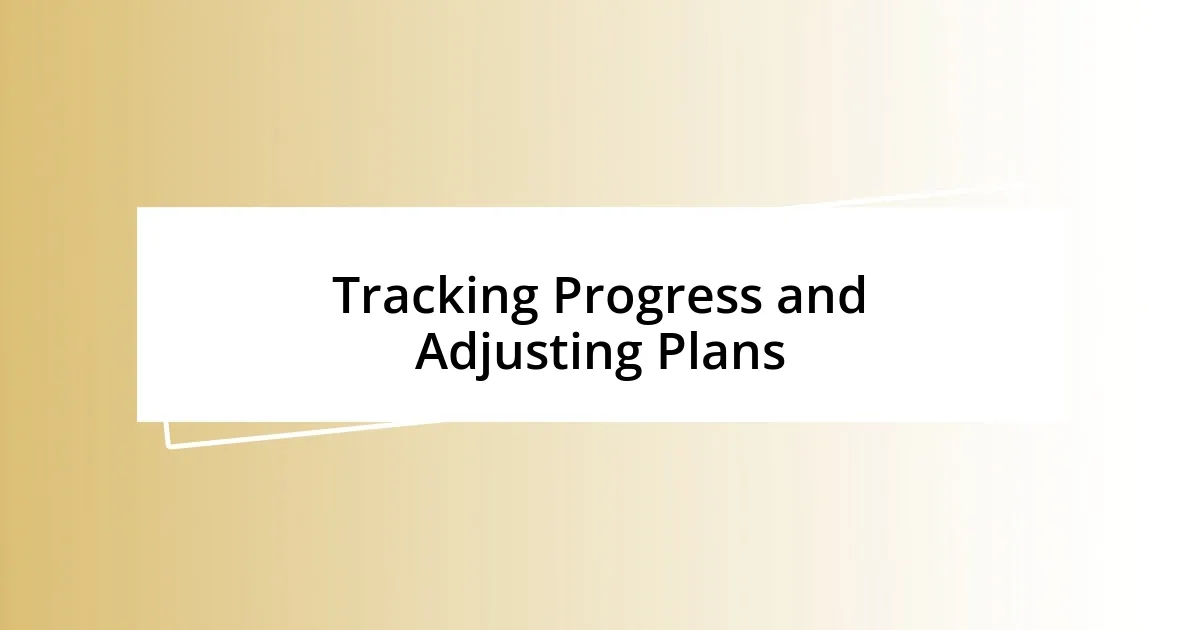Key takeaways:
- Understanding macronutrients and portion sizes transformed the author’s perspective on food, emphasizing the importance of nutrient-dense choices for energy and well-being.
- Identifying personal dietary needs involves considering factors such as age, activity level, and health conditions, leading to tailored nutrition strategies.
- Setting realistic nutrition goals and meal planning contributes to a sustainable, healthier lifestyle by enabling small, manageable changes.
- Tracking progress and being flexible with plans helps the author adapt to life changes and maintain motivation in their nutrition journey.

Understanding Nutrition Basics
Understanding the basics of nutrition has been a game changer for me. I remember when I first started learning about macronutrients—carbohydrates, proteins, and fats—and how they fuel our bodies. It was like removing a fog from my perspective on food; I began to see food not just as meals but as vital sources of energy.
Have you ever stood in front of a plate full of food and felt confused about what to eat? I certainly have. Grasping the importance of vitamins and minerals helped me answer that question. Once, during a particularly hectic week, I opted for a quick meal loaded with processed ingredients. Later, I felt drained and unfocused, which taught me that nutrient-dense foods have a profound effect on my mental clarity and overall well-being.
Understanding portion sizes also significantly shifted how I approach my meals. I used to load my plate without thinking, but now I pay attention to what my body truly needs. By practicing mindful eating, I discovered how satisfying a balanced plate can be, leaving me feeling more energized and less bloated—who doesn’t want that?

Identifying Your Dietary Needs
Identifying your dietary needs can feel overwhelming at first, but I’ve found it to be a crucial step in my nutrition journey. I remember sitting with a nutritionist who helped me pinpoint my specific requirements based on my lifestyle and health goals. It was enlightening to realize that everyone’s needs are unique and that there’s no one-size-fits-all approach. For instance, they emphasized the importance of understanding my activity level and energy needs, which significantly shaped my choices.
Here are some key factors to consider when identifying your dietary needs:
- Age and Gender: Nutritional needs can vary significantly; for example, women typically require more iron.
- Activity Level: More active individuals often need additional calories and nutrients.
- Health Conditions: Certain conditions, like diabetes, require tailored dietary adjustments.
- Allergies and Intolerances: Identifying these can help avoid foods that may harm your health.
- Personal Goals: Whether it’s weight loss, muscle gain, or maintaining health, different goals require different strategies.
Reflecting on these factors not only provides clarity but also fosters a connection to food that aligns with my personal journey toward better nutrition. I’ve learned that recognizing what I need is just the beginning; it’s about making informed choices that cater to my unique state of being.

Setting Realistic Nutrition Goals
Setting realistic nutrition goals is essential in crafting a sustainable journey toward better health. Early on, I felt overwhelmed thinking about drastic changes, but I soon realized that setting smaller, achievable goals made all the difference. For instance, instead of committing to a complete diet overhaul, I started by aiming to incorporate one new vegetable into my meals each week. That simple habit not only diversified my diet but also made me excited about exploring new flavors.
As I progressed, I learned the value of tracking my intake in a non-restrictive way. I remember entering my meals into a food journal, which transformed my awareness around what I was eating. This practice didn’t just highlight where I was lacking; it revealed moments when I was feeding my body with foods that truly nourished me. It felt empowering to recognize these choices without judgment—rather, I viewed each entry as a step towards understanding my personal nutrition landscape.
It’s also important to regularly reassess these goals. Life can bring unexpected changes, whether it’s a new job or a shift in family responsibilities. For me, when my schedule got busier, I adjusted my goals to focus on quick, nutritious meals that fit into my time constraints. By being flexible and patient with myself, I discovered that nutrition is a continuous journey, not a destination.
| Non-Realistic Goals | Realistic Goals |
|---|---|
| Completely eliminating certain food groups | Incorporating more whole foods gradually |
| Restricting calories drastically | Tracking intake moderately without stress |
| Rapid weight loss | Sustainable changes like losing 1-2 pounds a week |

Meal Planning for Success
Meal planning has undeniably been a game-changer in my journey towards better nutrition. I vividly remember the first time I dedicated an hour on a Sunday afternoon to outline my meals for the week. It felt like a small victory, but the relief I experienced each day knowing what I was having for dinner was profound. Have you ever felt that sense of chaos when you realize it’s dinner time and you have no plan? That’s where meal planning comes in. It not only saves me from those last-minute takeout decisions but also empowers me to make healthier choices.
I found it helpful to create a visual meal plan that I could hang on my fridge. Initially, that felt a bit too rigid for my liking, but then I realized it could actually make my week more flexible. I allowed some wiggle room for spontaneous meals or social gatherings, which kept me from feeling restricted. Plus, having that visual guide helped me ensure I was incorporating all the food groups, making for more balanced meals. Isn’t it satisfying to see a week’s worth of nutritious food laid out before you?
Cooking ahead of time has also been a lifesaver. I recall a particularly hectic week when I prepped several meals in advance—think big pots of vegetable-laden chili and wholesome grain bowls. Those ready-to-go meals became my safeguard against unhealthy snacking during my busy workdays. Each time I reached for one of those prepped dishes, I felt a sense of accomplishment. It was as if I was saying to myself, “You’ve got this.” Meal planning transformed from a chore into a ritual that nurtured not only my body but also my overall well-being.

Incorporating Healthy Foods Daily
Incorporating healthy foods into my daily routine has been all about finding joy in the process. I still remember the thrill of discovering a farmers’ market in my neighborhood. Picking out fresh, colorful produce was not just a chore; it became an exciting weekend ritual. Have you ever felt the difference when you buy fruits and vegetables that are in season? The flavors are vibrant, and it makes you want to incorporate them into every meal.
I also started experimenting with new recipes that center on healthy ingredients. One day, I decided to whip up a quinoa salad with roasted vegetables and a zesty dressing. As I mixed everything together, I felt a burst of creativity—it wasn’t just cooking; it was an expression of my journey towards better nutrition. Each time I tried something new, that sense of adventure kept me motivated and excited about my meals.
Another crucial aspect I’ve found is the importance of making healthier options easily accessible. I dedicated a small part of my kitchen to keep fresh fruits ready to grab and go. This simple act made snacking on an apple or a handful of almonds a no-brainer. Instead of reaching for that tempting bag of chips, I found myself choosing the nourishing option because it was there, waiting for me. Why complicate things when health can be so convenient?

Overcoming Common Nutrition Challenges
Navigating the minefield of nutrition challenges can feel overwhelming at times, and I totally get that. There were periods when I struggled with cravings, especially for sugary snacks. I remember one particularly late night while working on a project; the siren call of cookies was almost irresistible. To combat that, I introduced a few go-to healthier alternatives, like yogurt with honey or a piece of dark chocolate. The first few times it felt like a compromise, but eventually, I realized that choosing these options did more than satisfy my cravings; it made me feel proud of my choices.
Another hurdle I’ve faced is managing time during busy days. On those hectic mornings, I often found myself skipping breakfast or settling for something less nutritious. I started setting aside just 10 minutes the night before to prep easy grab-and-go meals—think overnight oats or smoothie bags. I still remember one morning racing out the door, only to grab a pre-packed smoothie I had prepped the night before. It wasn’t just a drink; it was fuel for my day. Who knew that little investment of time could alter my mornings so drastically?
I also encountered social situations that challenged my nutrition goals. It can feel isolating when your friends are ordering pizza while you’re trying to stick to a healthier plan. I’ve found that speaking up about my goals at these gatherings has been incredibly helpful. One time, I suggested a potluck format where everyone brought a healthy dish. Not only did it take the pressure off me, but it also encouraged others to explore nutritious options. Have you ever noticed how sharing food can create a supportive environment? It turned out to be a fun evening, filled with delicious, health-focused dishes, and made me realize that good nutrition doesn’t have to be a solo journey.

Tracking Progress and Adjusting Plans
Tracking my nutrition progress has been a game-changer on this journey. I recall downloading a food-tracking app that allowed me to log what I ate each day. At first, it felt tedious, but over time, I found joy in seeing the patterns evolve. I would often ask myself, “Am I hitting my nutrient goals?” and the answer became clearer with each entry.
Adjusting my plans is just as crucial as tracking them. There were weeks when I stuck to a routine, only to feel a slump in my energy levels. I realized I needed to shake things up, so I introduced new foods into my diet based on what I was missing. For example, I discovered that incorporating more legumes made a noticeable difference in how I felt. Have you ever tweaked your meals based on your body’s signals? It’s enlightening how quickly I could pivot and feel revitalized.
I also learned the importance of reflecting on my progress regularly. Every Sunday, I carve out time to review my week—what worked, what didn’t, and what made me feel good. One evening, sipping on herbal tea while journaling, I came to appreciate how far I’d come. Noticing how much more energized and fulfilled I felt helped reinforce my commitment. Isn’t it amazing how self-reflection can clarify our goals? This practice doesn’t just guide my next steps; it fuels my passion for maintaining a healthier lifestyle.














